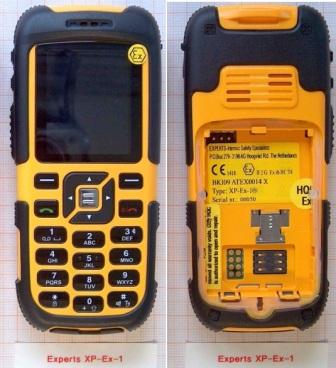Use of Mobile Phone "Expert XP-Ex-1" in Potentially Explosive Atmospheres
 | The Health & Safety Authority having been notified by the European Commission of serious potential dangers of a particular type of mobile phone which is marketed for use in potentially explosive atmospheres wishes to alert potential suppliers and users of these devices and advise to cease their supply or use in potentially explosive atmospheres.
The phone in question is the “Expert XP-Ex-1” manufactured by; Experts Intrinsic Safety Specialists, Groningsewet 7, 2994 LC Barendrecht, Netherlands. |
In light of the documentation available, and the comments or the absence of comments of the parties concerned, the European Commission considers that the Mobile Phone ‘Expert XP-Ex-1’ fails to comply with the essential health and safety requirements referred to in Article 3 of the Directive 94/9/EC and set out in Annex II, in particular in points 1.0.5 (Marking) and 1.3 (Potential ignition sources). These non-conformities and the related technical deficiencies give rise to serious risks for users.
Action required:
Suppliers
Suppliers should immediately cease the supply of these phones.
Users
Avoid using the phone in potentially explosive atmospheres.
Additional Information
The following is a link to the formal text of the European Commission Decision of the 14th of November giving effect to the prohibition.
If you have any further queries please contact;
The Health & Safety Authority, Workplace Contact Unit on 1890 289 389
Background Supporting Information;
On 8 April 2011, the Commission wrote to the manufacturer — Experts Intrinsic Safety Specialists — and to the Notified Body who issued the EC-Type Examination Certificate — BKIEx — ExVÁ Robbanásbiztos Berendezések Vizgáló Állomása Kft. Mikoviny Samuel u. 2-4, 1037 Hungary — Notified Body No 1418 inviting them to communicate their observations regarding measures taken by the German authorities.
To date, no reply has been received.
The potential danger associated with this type of mobile phone was identified initially by the German Authorities who have prohibited placing this type phone on the market. The European Commission has accepted this position and has instructed all member states of the EU to prohibit the placing on the market of this type of mobile phone. The phone does not meet the Essential Health & Safety Requirements as set out in Annex 2 of Directive 94/9/EC of the European Parliament and Council and as such does not comply with the requirements of the Second Schedule of S.I. No. 83/1999 — European Communities (Equipment and Protective Systems Intended For Use in Potentially Explosive Atmospheres) Regulations, 1999.
The German authorities indicated that their measure was based on the non-conformity of the product with the essential health and safety requirements referred to in Article 3 of Directive 94/9/EC and set out in Annex II, in particular in points
1.0.5 (Marking) and
1.3 (Potential ignition sources),
related to the incorrect application or shortcomings of the harmonised standard EN 60079- 11:2007 Explosive atmospheres — Part 11 — Equipment protection by intrinsic safety ‘i’ (IEC 60079- 11:2006), which is referred in the EC-Type Examination Certificate issued by BKIEx — ExVÁ:
— paragraph 5.3 (energy and power limitation not in accordance)
— paragraph 6.3.1.1 (minimum distances not kept: voltage 4.2 V needs a distance of 0.5 mm; the existing distance is about .2 mm)
— paragraph 10.5.3 (power supply not in accordance)
— capacitance of the main circuit board without limiting elements; maximum amount 299 μF is a multiple of 3,000 of the permissible limit.
According to the German authorities, the Mobile Phone does not meet the essential health and safety requirements of Directive 94/9/EC for electrical equipment of Category 2: it can produce hazardous sparks in case of faults, therefore the requirements intrinsic safety protection are not fulfilled. The German authorities conclude that this product is not safe for use in Zone 1 environments (Category 2G) and represents a real ignition danger in the case of intended use.
END 15/12/2011
